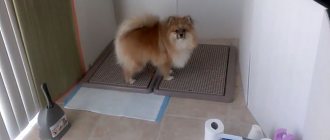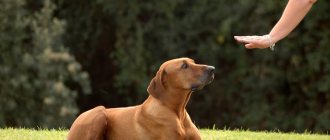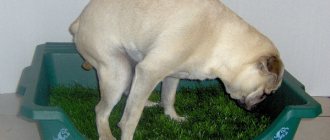How to train a dog to toilet outside and how long can it take?
As a rule, the main factors influencing the duration of training for a four-legged friend are the age of the dog (puppies learn faster than adults), physiological characteristics (it is difficult for a dog to cope with a natural urge if he suffers from incontinence or cystitis), and also the behavior of those who tamed an animal - the success of the undertaking depends on the chosen tactics.
Interesting fact
A number of dog breeders associate the habit of doing their business at home with the duration of the animal’s “exclusion” from the street at a very young age. Let us remind you that after all the necessary vaccinations, the puppy must withstand a kind of quarantine (not see other dogs). Therefore, many owners begin to take their children for walks when they are 3-4 months old. And during this period we are dealing with a pet who has clearly learned that his toilet is at home in a diaper or in a tray. Naturally, he will not walk on the street - this contradicts his already formed way of life.
It is difficult to retrain a child if the habit has become second nature. You need to take your puppy for a walk - you don’t have to leave him in captivity at home. You can also avoid the company of other dogs while walking - the main thing is not to visit places where other owners walk their pets. Otherwise, you are given complete freedom of action. When the baby sits down on the grass, do not pull him back or disturb him - let him do his job. And then be sure to praise and don’t forget to give a treat - such encouragement will help you quickly get used to new conditions.
Teaching a puppy
Puppy relieves himself on carpet at home
Ideal age
When talking about the age at which you need to teach a dog to go to the toilet outside, experts disagree. According to the most common opinion, the ideal age is 4-6 months. It is during this period that the puppy begins to correlate desires with actions. By this age, he is developing quite well physiologically, which allows him to endure, and not defecate at the first whim.
Preparation
When teaching your puppy to relieve himself outside, you need to remember four things:
- A dog is not a robot. At first, success and failure may alternate. If the puppy went to the toilet twice outside, and the third time at home, there is no need to sound the alarm. He needs time to adapt to new requirements.
- First, you will have to control literally every movement of the puppy. You need to learn to understand whether he wants to go to the toilet or not. Moreover, understand immediately, and not immediately before the undesirable action.
- It is better to start training your puppy to go to the toilet outside if he is accustomed to defecating in the same place in the house. You can do without this, but it will be more difficult.
- You will have to go outside up to 10-12 times a day. It may happen that you have to take your dog outside at 2-3 am.
Learning process
- Choose a few free days during which you can be at home. These may be weekends or holidays. Plan your time so that you don't have to leave home.
- Prepare a treat. If you walk your puppy with a collar and leash, prepare them too.
- Watch your puppy carefully. When you see him about to relieve himself, immediately take him outside. The faster the better.
- If possible, choose the quietest place where the dog will not be disturbed by outside factors. Avoid dog walking areas, children's playgrounds, and places near highways.
- Release the puppy. If you are not using a leash, simply let the animal out of your hands. If you are walking on a leash, let your dog fly freely away from you. Do not disturb the puppy by tugging on the leash or calling.
- Wait until the puppy goes to the toilet.
- Instantly praise him and reward him with a treat.
These steps should be repeated every time your puppy needs to go to the toilet. The most important thing is to be systematic (at least for several days in a row). You cannot be lazy and allow your puppy to go to the toilet at home if you have already started teaching him to do it outside.
You should not take your puppy home immediately after he defecates. You need to walk for at least another 10-15 minutes to make your trip outside more or less a full-fledged walk. It will be great if during this short walk the puppy goes to the toilet one more time. Naturally, the pet needs to be praised every time. If you decide to reward your puppy with a treat, you need to do this every time, without missing the reward.
Do not be surprised
- Puppies have a very fast metabolism. They may go to the toilet very often. Dogs begin to tolerate it only from the age of six months.
- A puppy under 4 months of age may not be physically able to restrain himself. Therefore, training started too early will be stressful for both you and him.
- A young dog, rejoicing at the owner’s arrival home, can “pee with joy” right in the hallway. You can't blame him for this.
How to train a dog to toilet outside if there is no place to walk with the puppy?
photo from the site: www.uznayvse.ru
There are also such situations: there are packs of stray dogs around the house, there are no clean walking areas, and it’s practically impossible to get to the park. In this case, we act by replacing the usual filler or diaper with something that will perform their functions - a handful of earth. Pour it into the tray and watch the dog’s behavior. If you notice that he is restless, sits down and sniffs, put him in an impromptu “clearing”. As soon as your baby completes the task, treat him to something tasty - for example, a special treat for puppies (biscuits).
Is it possible to punish the culprit if he left something in the wrong place? This needs to be done without physical force - just a threatening tone and pressing the puppy’s face to the floor - like, “look what you’ve done and don’t do it again.” However, such instruction only makes sense if you have witnessed a “crime.” It is useless to shout at your dog when you return home after work and find a puddle on the floor - the pet simply will not understand why you were offended.
Important
When trying to understand how to train a dog to ask to go outside or get used to it after diapers, you need to learn a common truth - if you don’t have time to walk your pet, you shouldn’t expect instant obedience from him. Imagine yourself in the place of an animal - you would hardly want to wait until the evening. Don't force your pet to endure it. Walk your dog regularly - during “training”, not only in the morning and evening, but 5-6 times a day.
Here are some tips for those who want to train their puppy to potty outside:
- As soon as the baby does his job, play with him, not forgetting to treat him with a treat. Don't rush to take him home. It is better to reschedule all games, starting them when your pet pleases you with the right actions. This will show him that he did well and deserves praise.
- The dog should be taken out either after sleep or after eating. Try to keep track of what time the puppy goes to the toilet - by checking this schedule you can avoid unpleasant surprises at home, taking them away before he wants to “inherit”.
- Be sure to check your pet's health status with a veterinarian - if the animal develops diarrhea or cystitis, your attempts will lead to nothing, and the condition of the puppy or adult dog will worsen. Eliminate the cause of the problem and only then begin training.
Description of approaches
Each dog, like a person, needs its own approach. What works for one may not work for another. The main factors that will influence the choice of outdoor toilet training method:
- dog's age;
- where did you get it from: the little puppy came from a breeder and already knows how to walk in a diaper, the dog was taken from a shelter or straight from the street;
- the animal’s readiness to fulfill the owner’s requirements (can it already carry out basic commands);
- the character of a particular animal.
The first two factors will be key when choosing a method. Of course, it is easier to train a puppy than an adult dog.
Depending on these factors, you will have to choose a method by which you will need to systematically and patiently train your dog to defecate outside.
What to do if an adult dog cannot stand going outside?
photo from website: elhow.ru
In this case, you will have to be a little more patient, because raising an adult dog is a little more difficult than raising a baby. However, nothing is impossible - just try to take the dog out every time after he drinks or eats - morning, afternoon and evening. Agree with a relative or friend if you don’t have enough time to walk your pet. Grown-up animals love to be praised just as much as puppies - don't skimp on encouragement and you will be rewarded.
How to clean up after your dog on the street?
photo from the site: animal.ru
In Russia, cleaning up after your pets is more a rarity than a common occurrence. When taking your dog to the park or outside, think about it: would I want to go where someone else’s animal went to the toilet before? Those who want to take care of the cleanliness of walking areas should follow simple rules:
- Special plastic bags or newspapers are ideal for cleaning up feces (it’s better to take several of them with you at once).
- You can pick up the excrement by putting a bag on your hand or using a scoop.
- Garbage should be thrown into a nearby trash bin.
- Don't forget to wash your hands or use an alcohol-based hand sanitizer.
What should you do if your dog can’t stand going outside because he’s afraid to walk in parks or special areas? In this case, there is only one option - systematic training, which may require consultation with a veterinarian or animal psychologist. Do not forget that for a puppy, the first “outings” are real stress that is difficult to survive. Walk away from highways and the noise of passing cars at quiet times - in the morning or evening, when there are fewer potential irritants.
If the problem occurs in an adult dog, begin to get acquainted with the outside world carefully - in several stages. Teach your pet to obey your will - if the dog understands that you are the leader, under whose protection nothing threatens him, he will follow you anywhere.
Should a dog tolerate
There is probably no dog owner in the world who would not dream that his pet would finally learn to go outside 2 times a day and not crap in the apartment. But, unfortunately, such a time does not come immediately, especially if the owner himself does nothing for this.
September 10, 2012
Some dog breeders, especially those new to this business, will exclaim: “She also needs to be taught!?” What did you think? As a child, you were taught to eat from a spoon, drink from a mug, and go to the potty. So the dog requires the same training, and it can take much more time than training small children.
If you don’t explain to your dog from early childhood that you need to walk twice a day, and the rest of the time he will have to be patient a little, then this process can drag on for more than one month or even a year. Therefore, everything depends only on you and your patience.
But there is a certain percentage of people who believe that the dog should under no circumstances wait until the next walk.
Which of these sides is right? Should a dog endure it?
It can be assumed that both are right, since in both cases there are moments that are convenient for both the owners and the dog itself.











